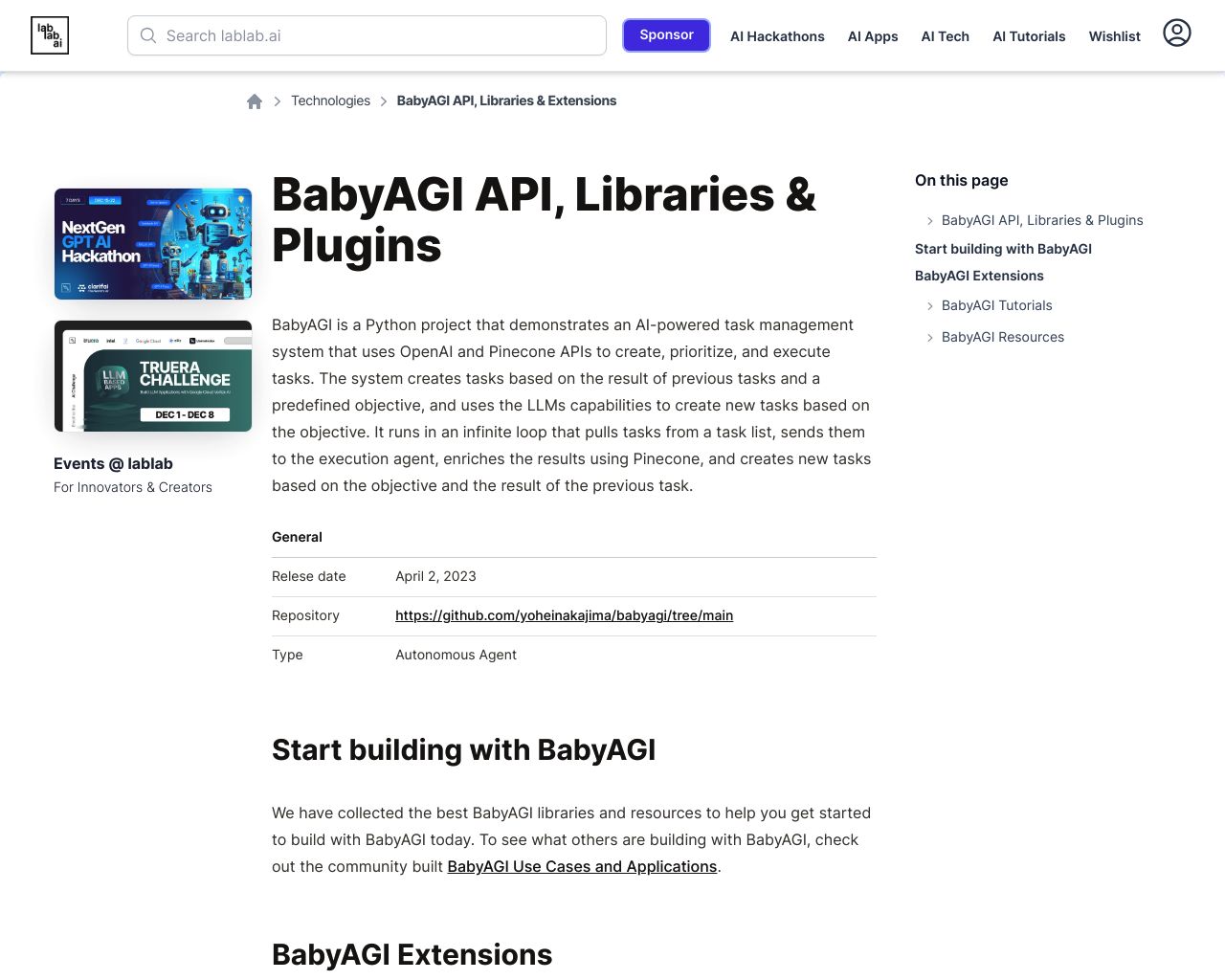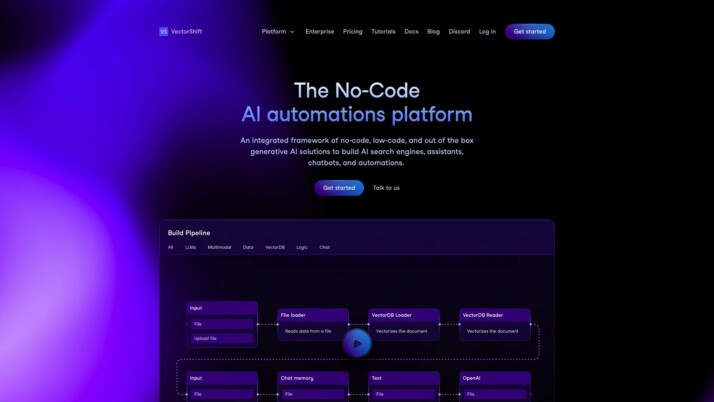BabyAGI vs. VectorShift: Comparing AI Automation Platforms
AI platforms BabyAGI vs. VectorShift offer distinct approaches to task automation and workflow management, each with unique strengths and limitations. This comparison examines their core features, usability, and potential applications across various industries. We’ll explore how BabyAGI’s focus on autonomous learning contrasts with VectorShift’s emphasis on user-friendly interfaces and integration capabilities.
By analyzing these platforms alongside SmythOS, we aim to provide developers, business leaders, and AI enthusiasts with insights to make informed decisions about which solution best fits their needs. Whether you’re building complex AI systems or seeking to streamline business processes, understanding the nuances of these platforms is crucial in today’s AI-driven landscape.
BabyAGI Overview
BabyAGI represents an innovative open-source project in artificial intelligence, designed to mimic human-like cognitive processes for autonomous task management. Developed by Yohei Nakajima, this platform pushes the boundaries of AI by simulating aspects of artificial general intelligence (AGI).


BabyAGI’s core functionality revolves around autonomous task generation, prioritization, and execution. Unlike traditional AI systems focused on specific tasks, BabyAGI creates and manages dynamic lists of subtasks based on given objectives. The system continuously learns from previous tasks and adapts to new challenges, employing advanced natural language processing capabilities from OpenAI and vector databases like Pinecone for storing and retrieving task results.
BabyAGI creates and manages dynamic lists of subtasks based on given objectives. The system continuously learns from previous tasks and adapts to new challenges…
Key features of BabyAGI include its ability to generate new tasks autonomously based on previous results and predefined objectives, efficiently prioritize tasks, and integrate memory and learning capabilities to improve over time. This adaptability allows BabyAGI to perform complex problem-solving activities across various fields, from customer service and healthcare to education and creative writing.
However, BabyAGI has limitations. It lacks a visual builder or no-code editor, requiring users to have coding knowledge, particularly in Python. The platform doesn’t offer specific debug modes, multimodal capabilities, or features for multi-agent collaboration. Additionally, it doesn’t provide built-in solutions for human-AI interaction, audit logs, or team collaboration features.
Despite these constraints, BabyAGI’s approach to AI, focusing on autonomous task management and human-like learning, positions it as a valuable tool in the development of artificial general intelligence. Its ability to adapt, learn, and prioritize tasks autonomously makes it an asset for numerous applications, offering a glimpse into the future of intelligent automation.
VectorShift Overview
VectorShift empowers users to create and manage AI workflows through an innovative platform that bridges the gap between technical and non-technical users. The software offers dual interfaces — a no-code builder and a code SDK — enabling diverse teams to design, prototype, build, deploy, and manage generative AI workflows and automations.


At the heart of VectorShift lies the pipeline dashboard, allowing users to craft AI workflows from scratch or leverage pre-built templates. This core feature streamlines the deployment process, making it efficient and accessible. The platform’s versatility shines through its support for a wide array of applications, including chatbots, search functionalities, automations, and content creation.
VectorShift empowers users to create and manage AI workflows through an innovative platform that bridges the gap between technical and non-technical users.
VectorShift’s comprehensive automation capabilities set it apart. Users can automate workflows end-to-end, schedule tasks to run at specific intervals, and trigger actions based on predefined events like email receipts or Slack messages. The platform seamlessly integrates with popular data sources such as Google Drive, Slack, OneDrive, and Airtable, centralizing data management and enabling live-syncing across applications.
VectorShift excels in content creation, generating marketing copy, personalized emails, call summaries, proposals, and graphics at scale in predefined formats and styles. The platform’s robust knowledge base centralizes data and performs semantic searches, enhancing the AI’s ability to provide accurate and relevant information. Deployment options are flexible, allowing pipelines to be implemented as chatbots, automations, or search functions, with various customization and export options including URL, iFrame, WhatsApp/SMS bots, API endpoints, and Slack App bots.
While VectorShift offers impressive capabilities, it’s worth noting that the platform may have a learning curve for users new to AI workflows. Additionally, as with any AI tool, the quality of outputs depends on the quality of inputs and training data provided. Despite these considerations, VectorShift’s vision to democratize AI workflow creation and management positions it as a powerful tool for businesses seeking to leverage AI across various applications and industries.
Feature Comparison
BabyAGI and VectorShift offer contrasting approaches to AI agent development, with significant feature gaps in core components and security. BabyAGI, an open-source project, focuses on autonomous task management and learning but lacks many of the user-friendly features and deployment options that VectorShift provides.
VectorShift’s no-code builder and code SDK offer dual interfaces for both technical and non-technical users, a feature absent in BabyAGI. This accessibility gap extends to deployment options — VectorShift allows deployment as chatbots, APIs, and scheduled agents, while BabyAGI requires more technical setup. VectorShift’s integration with popular data sources and APIs also outpaces BabyAGI’s capabilities in this area.
In terms of security, VectorShift offers more robust features including data encryption and integration with various authentication methods. BabyAGI, while powerful in its autonomous capabilities, does not explicitly address these security concerns in its current implementation. This security gap could be significant for enterprise users or those handling sensitive data.
Feature Comparison Table
| BabyAGI | VectorShift | SmythOS | |
|---|---|---|---|
| CORE FEATURES | |||
| Hosted Agents (Dev, Production) | ❌ | ❌ | ✅ |
| Environments (Dev, Production) | ❌ | ❌ | ✅ |
| Visual Builder | ❌ | ✅ | ✅ |
| No-Code Options | ❌ | ✅ | ✅ |
| Autonomous Agents | ✅ | ❌ | ✅ |
| Explainability & Transparency | ❌ | ❌ | ✅ |
| Debug Tools | ✅ | ❌ | ✅ |
| Multi-Agent Collaboration | ✅ | ❌ | ✅ |
| Human-AI Interaction | ❌ | ✅ | ✅ |
| Audit Logs for Analytics | ❌ | ❌ | ✅ |
| Agent Work Scheduler | ❌ | ✅ | ✅ |
| Logs & Monitoring | ❌ | ✅ | ✅ |
| SECURITY | |||
| Constrained Alignment | ❌ | ❌ | ✅ |
| Data Encryption | ✅ | ❌ | ✅ |
| IP Control | ❌ | ❌ | ✅ |
| COMPONENTS | |||
| Foundation AIs | ❌ | ✅ | ✅ |
| Huggingface AIs | ✅ | ❌ | ✅ |
| Zapier APIs | ✅ | ❌ | ✅ |
| Classifiers | ✅ | ❌ | ✅ |
| Data Lakes | ❌ | ❌ | ✅ |
| DEPLOYMENT OPTIONS (EMBODIMENTS) | |||
| Staging Domains | ❌ | ❌ | ✅ |
| Production Domains | ❌ | ❌ | ✅ |
| Deploy as Scheduled Agent | ❌ | ✅ | ✅ |
| Deploy as GPT | ✅ | ❌ | ✅ |
| DATA LAKE SUPPORT | |||
| Sitemap Crawler | ❌ | ❌ | ✅ |
| YouTube Transcript Crawler | ❌ | ✅ | ✅ |
Best Alternative to BabyAGI and VectorShift
SmythOS stands out as the superior alternative to BabyAGI and VectorShift for AI agent development. Our platform combines powerful features with unmatched ease of use, empowering users to create sophisticated AI solutions without limitations.
We offer a comprehensive suite of tools that surpass the capabilities of both BabyAGI and VectorShift. Our visual drag-and-drop interface allows users to build complex AI workflows effortlessly, eliminating the need for extensive coding knowledge. This approach democratizes AI development, making it accessible to technical and non-technical users alike.
SmythOS provides a versatile environment for creating AI agents capable of handling diverse use cases. From chatbots and search functionalities to complex automations, our platform adapts to your specific requirements.
Unlike BabyAGI’s narrow focus on autonomous task management, SmythOS provides a versatile environment for creating AI agents capable of handling diverse use cases. From chatbots and search functionalities to complex automations, our platform adapts to your specific requirements. VectorShift may offer some automation capabilities, but SmythOS takes it further with advanced features like multi-agent collaboration and seamless API integrations.
Security and scalability set SmythOS apart from competitors. We prioritize data protection with robust encryption and access controls, addressing the security gaps present in both BabyAGI and VectorShift. Our platform scales effortlessly to meet enterprise-level demands, ensuring your AI solutions grow alongside your business needs.
With SmythOS, you gain access to a rich ecosystem of pre-built components, AI models, and integrations. This extensive library, combined with our intuitive interface, accelerates development and deployment of AI agents. Whether you’re a startup looking to innovate quickly or an enterprise seeking to transform operations, SmythOS provides the ideal foundation for building the next generation of AI-powered solutions.
Conclusion
BabyAGI and VectorShift offer unique approaches to AI agent development, each with distinct strengths and limitations. BabyAGI excels in autonomous task management and learning, mimicking human-like cognitive processes. Its ability to generate, prioritize, and execute tasks autonomously makes it a powerful tool for complex problem-solving across various fields. However, BabyAGI’s lack of a user-friendly interface and limited deployment options may pose challenges for non-technical users.
VectorShift, on the other hand, provides a more accessible platform with its dual no-code and code SDK interfaces, catering to both technical and non-technical users. Its comprehensive automation capabilities, extensive integration options, and flexible deployment features make it a versatile choice for businesses looking to implement AI workflows across different applications.
While both platforms offer valuable solutions, SmythOS stands out as the superior option, combining the best of both worlds and addressing their limitations. Our platform offers a user-friendly drag-and-drop interface, extensive pre-built integrations, and support for a wide range of AI models. SmythOS enables the creation of multi-agent systems, provides versatile deployment options, and ensures robust security measures, making it the ideal choice for businesses seeking to harness the full potential of AI.
To experience the power of SmythOS and revolutionize your AI workflows, create a free account today. With our risk-free trial and unlimited agent creation, you can explore how SmythOS can transform your business processes and drive innovation. Discover our diverse range of AI-powered agent templates to jumpstart your AI journey and unlock new possibilities for your organization.
Last updated:
Disclaimer: The information presented in this article is for general informational purposes only and is provided as is. While we strive to keep the content up-to-date and accurate, we make no representations or warranties of any kind, express or implied, about the completeness, accuracy, reliability, suitability, or availability of the information contained in this article.
Any reliance you place on such information is strictly at your own risk. We reserve the right to make additions, deletions, or modifications to the contents of this article at any time without prior notice.
In no event will we be liable for any loss or damage including without limitation, indirect or consequential loss or damage, or any loss or damage whatsoever arising from loss of data, profits, or any other loss not specified herein arising out of, or in connection with, the use of this article.
Despite our best efforts, this article may contain oversights, errors, or omissions. If you notice any inaccuracies or have concerns about the content, please report them through our content feedback form. Your input helps us maintain the quality and reliability of our information.
